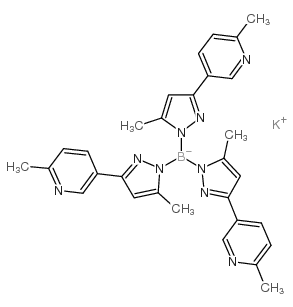Potassium hydrotris (3-(6-methyl-3-pyridyl)-5-methylpyrazol-1-yl)borate
Modify Date: 2024-01-31 16:33:11

Potassium hydrotris (3-(6-methyl-3-pyridyl)-5-methylpyrazol-1-yl)borate structure
|
Common Name | Potassium hydrotris (3-(6-methyl-3-pyridyl)-5-methylpyrazol-1-yl)borate | ||
|---|---|---|---|---|
| CAS Number | 184032-07-3 | Molecular Weight | 566.52900 | |
| Density | N/A | Boiling Point | N/A | |
| Molecular Formula | C30H30BKN9 | Melting Point | 198ºC | |
| MSDS | N/A | Flash Point | N/A | |
| Name | Potassium hydrotris (3-(6-methyl-3-pyridyl)-5-methylpyrazol-1-yl)borate |
|---|
| Melting Point | 198ºC |
|---|---|
| Molecular Formula | C30H30BKN9 |
| Molecular Weight | 566.52900 |
| Exact Mass | 566.23500 |
| PSA | 92.13000 |
| LogP | 5.24210 |
|
Section 1: Product Identification Chemical Name:Potassium hydrotris(3-(6-methyl-3-pyridyl)-5-methylpyrazol-1-yl)borate, 97% CAS Registry Number:184032-07-3 Formula:[C30H31BN9]K EINECS Number:none Chemical Family:organic or inorganic borate Synonym:None
Section 2: Composition and Information on Ingredients IngredientCAS NumberPercentACGIH (TWA)OSHA (PEL) Title compound184032-07-3100%no datano data Section 3: Hazards Identification Emergency Overview:Irritating to skin, eyes and respiratory tract. Primary Routes of Exposure:Ingestion, inhalation Eye Contact:Causes slight to mild irritation of the eyes. Skin Contact:Causes slight to mild irritation of the skin. Inhalation:Irritating to the nose, mucous membranes and respiratory tract. No specific information is available on the physiological effects of ingestion. May cause vomiting and diarrhea. Ingestion: Acute Health Affects:Irritating to skin, eyes and respiratory tract. Chronic Health Affects:No information available on long-term chronic effects. NTP:No IARC:No OSHA:No SECTION 4: First Aid Measures Immediately flush the eyes with copious amounts of water for at least 10-15 minutes. A victim may need Eye Exposure: assistance in keeping their eye lids open. Get immediate medical attention. Wash the affected area with water. Remove contaminated clothes if necessary. Seek medical assistance if Skin Exposure: irritation persists. Remove the victim to fresh air. Closely monitor the victim for signs of respiratory problems, such as difficulty Inhalation: in breathing, coughing, wheezing, or pain. In such cases seek immediate medical assistance. Seek medical attention immediately. Keep the victim calm. Give the victim water (only if conscious). Induce Ingestion: vomiting only if directed by medical personnel. SECTION 5: Fire Fighting Measures Flash Point:none Autoignition Temperature:none Explosion Limits:none Extinguishing Medium:carbon dioxide, dry powder or foam If involved in a fire, fire fighters should be equipped with a NIOSH approved positive pressure self-contained Special Fire Fighting Procedures: breathing apparatus and full protective clothing. Hazardous Combustion andIf involved in a fire this material may emit toxic organic fumes. Decomposion Products: Unusual Fire or Explosion Hazards: No unusual fire or explosion hazards. SECTION 6: Accidental Release Measures Spill and Leak Procedures:Small spills can be mixed with vermiculite or sodium carbonate and swept up. SECTION 7: Handling and Storage Handling and Storage:Store in a tightly sealed container. Keep away from heat and moisture. SECTION 8: Exposure Controls and Personal Protection Eye Protection:Always wear approved safety glasses when handling a chemical substance in the laboratory. Skin Protection:Wear protective clothing and gloves. Ventilation:If possible, handle the material in an efficient fume hood. If ventilation is not available a respirator should be worn. The use of respirators requires a Respirator Respirator: Protection Program to be in compliance with 29 CFR 1910.134. Ventilation:If possible, handle the material in an efficient fume hood. Additional Protection:No additional protection required. SECTION 9: Physical and Chemical Properties Color and Form:white powder Molecular Weight:567.54 Melting Point:198° Boiling Point:no data Vapor Pressure:no data Specific Gravity:no data Odor:none Solubility in Water:slightly soluble SECTION 10: Stability and Reactivity Stability:air and moisture-stable solid Hazardous Polymerization:none Conditions to Avoid:none Incompatibility:strong oxidizing agents Decomposition Products:carbon dioxide, carbon monoxide, boron oxides, andorganic fumes. SECTION 11: Toxicological Information No specific information available on this product. Boron effects the central nervous system. Poisoning causes RTECS Data: depression of the circulation, vomiting and diarrhea followed by shock and coma. Carcinogenic Effects:No data available Mutagenic Effects:No data available Tetratogenic Effects:No data available SECTION 12: Ecological Information Ecological Information:No information available SECTION 13: Disposal Considerations Disposal:Dispose of according to local, state and federal regulations. SECTION 14: Transportation Shipping Name (CFR):Non-hazardous Hazard Class (CFR):NA Additional Hazard Class (CFR):NA Packaging Group (CFR):NA UN ID Number (CFR):NA Shipping Name (IATA):Non-hazardous Hazard Class (IATA):NA Additional Hazard Class (IATA):NA Packaging Group (IATA):NA UN ID Number (IATA):NA SECTION 15: Regulatory Information TSCA:not listed on the TSCA inventory SARA (Title 313):not regulated by Title 313 Second Ingredient:none SECTION 16 - ADDITIONAL INFORMATION N/A |

